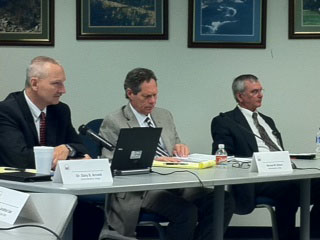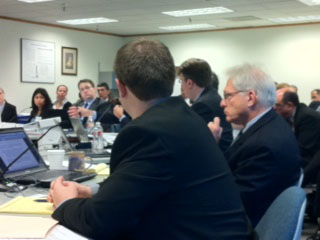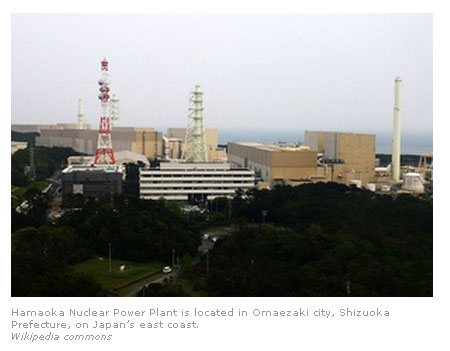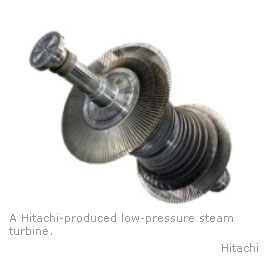Archive for the ‘News’ Category
Hearing on foreign ownership of proposed South Texas Nuclear Reactors
August 17, 2011

Atomic Safety and Licensing Board -Judges Gary Arnold, Michael Gibson, Randall Charbeneau

Hearing on the application to expand the South Texas Nuclear plant earing underway.
Intervenor’s Foreign Control Contention for Proposed South Texas Project nuclear reactors
Tepco Detects Nuclear Fission at Fukushima Dai-Ichi Station
November 02, 2011
By Tsuyoshi Inajima and Yuji Okada
Bloomberg Businessweek
Nov. 2 (Bloomberg) — Tokyo Electric Power Co. detected signs of nuclear fission at its crippled Fukushima atomic power plant, raising the risk of increased radiation emissions. No increase in radiation was found at the site and the situation is under control, officials said.
The company, known as Tepco, began spraying boric acid on the No. 2 reactor at 2:48 a.m. Japan time to prevent accidental chain reactions, according to an e-mailed statement today. The detection of xenon, which is associated with nuclear fission, was confirmed today by the Japan Atomic Energy Agency, the country’s atomic regulator said.
"Given the signs, it’s certain that fission is occurring," Junichi Matsumoto, a general manager at Tepco who regularly talks to the media, told reporters in Tokyo today. There’s been no large-scale or sustained criticality and no increase in radiation, he said.
Fission taking place in the reactor can lead to increases in radiation emissions and raises concerns about further leaks after another radioactive hot spot was discovered in Tokyo on Oct. 29. It’s possible there are similar reactions occurring in the No. 1 and No. 3 reactors, the other cores damaged at the station, Matsumoto said.
"Melted fuel in the No. 2 reactor may have undergone a sustained process of nuclear fission or re-criticality," Tetsuo Ito, the head of Kinki University’s Atomic Energy Research Institute, said by phone. "The nuclear fission should be containable by injecting boron into the reactor to absorb neutrons."
Loss of Cooling
Trade and Industry Minister Yukio Edano delivered a warning to Hiroyuki Fukano, the head of the Nuclear and Industrial Safety Agency, because the information on the discovery of xenon wasn’t passed to the prime minister’s office in a timely manner, Chief Cabinet Secretary Osamu Fujimura told reporters today.
Shares of Tepco declined 2.6 percent to close at 302 yen on the Tokyo Stock Exchange. They’ve fallen 86 percent since the disaster. The benchmark Nikkei 225 Stock Average was down 2.2 percent.
Eight months after the March 11 earthquake and tsunami wrecked the Fukushima Dai-Ichi plant, causing a loss of cooling and the meltdowns of three reactors, Tepco is trying to prevent further leakage of radiation that has spread across the world.
The incident, the worst atomic disaster since Chernobyl in 1986, was responsible for the biggest discharge of radioactive material into the ocean in history, according to a study from a French nuclear safety institute.
Evaluating Reactions
"We are evaluating whether there are many reactions or not or whether its stopped," Matsumoto said. The incident won’t affect its schedule of bringing the plant under control by the end of this year, Matsumoto said.
Yasuhiro Sonoda, a member of the ruling Democratic Party of Japan, on Oct. 31 drank a glass of filtered water from the Fukushima plant to demonstrate the situation is being brought under control.
Sonoda denied reporters’ claims it was a publicity stunt. "I drank it because there shouldn’t be any concerns about the water," he said. "I didn’t intend to say it’s completely safe by drinking it."
No significant changes in temperatures and pressures of the reactor and radiation levels at the site have been detected, said Hiroyuki Usami, a spokesman for Tepco.
Reactor Readings
The temperature of the bottom of the No. 2 reactor pressure vessel was 76 degrees Celsius (167 Fahrenheit) at 5 a.m. today, compared with 77.4 degrees a day earlier and 77.5 degrees two days ago, according to Tepco’s data. Radiation levels taken near the west gate of the plant have been stable at about 11 microsieverts per hour for the past few days, the data shows
Should fissioning have occurred the injection of boron will have stopped it, said Tadashi Narabayashi, a former reactor safety researcher at Toshiba Corp. and now a nuclear engineering professor at Hokkaido University.
Fissioning involves the splitting of atoms, which, in the case of certain uranium isotopes, can lead to an uncontrolled reaction and emittance of radiation.
Tepco and the government have said they are on track to bring the damaged reactors into a safe state known as cold shutdown by the end of the year.
Nuclear fission would be taking place in a "very restricted part" of the reactor, said Koganeya. The regulator believes fuel accumulated at the bottom of the pressure vessel and containment vessel is unlikely to start melting again, he said.
Damaged Reactors
Fukushima sustained major damage at four of its six reactor buildings at the Dai-Ichi plant, including the three core meltdowns and possible damage to a spent fuel pool.
The radioactive cesium that flowed into the sea from the plant was 20 times the amount estimated by Tepco, according to the Institute for Radiological Protection and Nuclear Safety, which is funded by the French government.
The oceanic study estimates 27,000 terabecquerels of radioactive cesium 137 leaked into the sea from the plant. The Fukushima station may have emitted more than twice the amount of radiation than estimated by the Japanese government at the height of the Fukushima accident, according to another study by the Atmospheric Chemistry and Physics journal.
Tepco has declined to comment on both studies.
–With assistance from Taku Kato, Sachiko Sakamaki and Takehiko Kumakura in Tokyo. Editor: Aaron Sheldrick
To contact the reporters on this story: Tsuyoshi Inajima in Tokyo at tinajima(at)bloomberg.net; Yuji Okada in Tokyo at yokada6(at)bloomberg.net
To contact the editor responsible for this story: Peter Langan at plangan(at)bloomberg.net
This document contains copyrighted material whose use has not been specifically authorized by the copyright owner. SEED Coalition is making this article available in our efforts to advance understanding of ecological sustainability, human rights, economic democracy and social justice issues. We believe that this constitutes a "fair use" of the copyrighted material as provided for in section 107 of the US Copyright Law. If you wish to use this copyrighted material for purposes of your own that go beyond "fair use", you must obtain permission from the copyright owner.
South Texas Project Hearing in Rockville, MD
October 31, 2011
South Texas Project Hearing in Rockville, MD

Hearing Announcement- U.S.NRC
Atomic Safety and Licensing Board
STP Evidentiary Hearing
October 31, 2011

Susan Dancer, of South Texas Association for Responsible Energy, is one of the Intervenors opposing proposed South Texas Project reactors, along with SEED Coalition and Public Citizen.

Attorney Bob Eye and energy efficiency expert Phil Mosenthal with Optimal Energy were impressive at the NRC hearing on October 31st in Rockville, Maryland!
Perry says he’s changed on energy loans
October 30, 2011
Politico
Texas Gov. Rick Perry acknowledged Sunday that he has changed his position on federal loans to energy companies.
"Fox News Sunday" host Chris Wallace pressed the Republican presidential candidate on a 2008 letter he wrote to the energy secretary, seeking federal support of a nuclear power generating facility in Texas.
"From a general standpoint, any type of federal dollars flowing into these industries we think is bad public policy, whether it’s the ethanol side, whether it’s nuclear power side, whether it’s oil and gas side," Perry said.
"Let me just tell you: I’ve changed my position from the standpoint of having any desire to have the federal government," he said. "I’ve learned some things over the course of the years, and what I’ve learned is the federal government, by and large, you keep ‘em out of these issues, particularly on the energy side."
"Let the market figure it out," he added. "Are you going to have the federal government making some impact on the nuclear energy side from the standpoint of research and development or having places to be able to deal with these spent fuels and reprocess them? Yes. But giving straight up money to energy? Do away with it."
This document contains copyrighted material whose use has not been specifically authorized by the copyright owner. SEED Coalition is making this article available in our efforts to advance understanding of ecological sustainability, human rights, economic democracy and social justice issues. We believe that this constitutes a "fair use" of the copyrighted material as provided for in section 107 of the US Copyright Law. If you wish to use this copyrighted material for purposes of your own that go beyond "fair use", you must obtain permission from the copyright owner.
COMMENT: Hit by a $1 billion liability verdict in Japan, Hitachi negotiates new reactor deal with Lithuania
October 17, 2011
Andrei Ozharovsky
Translated by Maria Kaminskaya
Bellona
A court in Tokyo has ruled Japan’s Hitachi liable for over $1 billion in damages resulting from an accident, and subsequent loss of profit, at Hamaoka Nuclear Power Plant’s (NPP) Hitachi-made ABWR reactor. Boiling reactors, to which the ABWR series belongs, have earned their share of infamy with Chernobyl’s explosion and the disaster at Fukushima– but they have also proven challenging both in operation and repairs. Still, Hitachi continues to promote ABWRs for export construction, including in Lithuania, where it hopes to build a new station to replace the shut-down Ignalina

Over a billion dollars for forced downtime
On October 6, 2011, the District Court of Tokyo issued a verdict that wrapped up a three-year-long litigation over the protracted repairs and resulting outage following an accident at Reactor Unit 5 of Japan’s Hamaoka Nuclear Power Plant, in Omaezaki city, Shizuoka Prefecture.
The court ruled the Japanese electronics and heavy industry giant Hitachi, which manufactured the turbine used at the plant, liable for paying Hamaoka’s operator entity, Chubu Electric Power Company, JPY 90 billion (or $1.17 billion) in compensation for the loss of profit that resulted from the downtime.
Because of problems with the Hitachi-made steam turbine, the reactor at Hamaoka remained in repairs for nearly eight months, since June 2006 to February 2007. The operator company brought a lawsuit in 2008 and the Tokyo District Court has now ruled in its favour.
Even though the steam turbine has been repaired, the plant will likely be completely decommissioned. Last May, according to a story by the BBC, Japan’s Prime Minister Naoto Kan asked Chubu to halt operations at the plant for fears of a repeat disaster of the Fukushima scenario. Extreme efforts to bring under control the nuclear and radiation catastrophe at Fukushima – which last March had been hit by the dual force of an earthquake and an estimated 15-metre tsunami wave, knocking that plant’s power supply and leading to multiple meltdowns and massive releases of radiation – had still been in progress at the time, and are ongoing now.
Hamaoka, located 200 kilometres southwest of Tokyo, is, too, in a seismic-prone area. According to an article by Bloomberg from last May, Kan "[cited] a government study that showed an 87-percent likelihood of a magnitude-8 quake striking the area within 30 years." Chubu Electric agreed to shut Hamaoka’s reactors down.
In Russia, equipment failures at nuclear power plants are not so infrequent and also lead to losses incurred to the operator company. The Russian Federal Service for Ecological, Industrial, and Atomic Supervision, or Rostekhnadzor, says the many disturbances or violations it registers in its yearly reports as occurrences disrupting the operation of Russian NPPs are the result of "such underlying causes as mismanagement, flaws in maintenance organisation, manufacturing defects, and design defects."
Each time a reactor undergoes unplanned repairs owing to an electrical or other equipment failure that results in an emergency shutdown, the nuclear power plant necessarily undersupplies electric power to consumers. Still, lawsuits such as the one heard in Tokyo are unlikely to happen in Russia since the entire industry – from the equipment suppliers to the NPP construction companies to the operator company – remains within the corporate umbrella of the State Nuclear Corporation Rosatom, with all potential disputes settled internally. Because the state is the corporation’s shareholder, all financial losses and costs incurred by emergency repairs are covered with funds provided from the federal budget.
The accident with the turbine
 Reactor Unit 5 at Hamaoka was commissioned in January 2005 and was the only one running a reactor of the ABWR type, which stands for Advanced Boiling Water Reactor, a Generation III boiling water reactor (BWR). The other four units at the plant operated BWRs.
Reactor Unit 5 at Hamaoka was commissioned in January 2005 and was the only one running a reactor of the ABWR type, which stands for Advanced Boiling Water Reactor, a Generation III boiling water reactor (BWR). The other four units at the plant operated BWRs.
The design, certified in 1997 by the US Nuclear Regulatory Commission, was developed by GE Hitachi Nuclear Energy, an alliance between General Electric and Hitachi. The plant is designed to produce electricity from a turbine generator unit using steam generated in the reactor, says a design description on the International Atomic Energy Agency website.
The accident at Unit 5 happened just eighteen months after the reactor launch. Reports say that in June 2006, turbulence occurred in the stream of radioactive steam flowing from the reactor into the turbine. That, combined with a high-velocity backflow of steam, caused strong vibrations in the turbine.
Of the 840 turbine blades, 622 were damaged as a result. Cracks appeared both in the blades and where they were joined to the turbine rotor. The accident also caused one of the blades to lose a fragment, which led to even more extensive damage.
The single 1,380-megawatt turbine used at the unit proved challenging to repair both on account of the scope of the damage incurred and because of the peculiarities of the ABWR design.
The ABWR is a single-loop reactor. Water is taken to a boil in the reactor vessel and the generated steam flows into the turbine to spin its blades and produce electric power. This approach – which replaced a two-loop system with a steam generator – was opted for in order to simplify the design and cut on operation costs.
In practical experience, however, boiling reactors proved difficult to repair. In a two-loop design, radioactive substances do not reach the turbine and it remains uncontaminated, so should it need repairs, no additional challenge is there to complicate the works.
However, nuclear power plants that use boiling reactors such as the Soviet-designed RBMK series (of which the RBMK-1000 model was used at Ukraine’s Chernobyl, and three Russian nuclear power plants continue to operate the same design) and the US-Japanese BWRs and ABWRs have to contend with turbines that get contaminated with radionuclides in the course of operation.
Special precaution is thus called for when repairing the turbine following a malfunction. Furthermore, the repair itself cannot be started immediately after an accident as a waiting period is needed until radioactivity levels, caused by the short-lived radionuclides in the steam, subside sufficiently to ensure safety.
Exploding reactors and imploding profits
Boiling reactors have not exactly shown a stellar record. It was a graphite-moderated boiling reactor, of the RBMK-1000 model, that exploded in Chernobyl in 1986.
And at Fukushima, even though it was the fatal loss of cooling at the plant, caused by the natural disaster, that was to propel the accident to catastrophic levels, the General Electric Mark I boiling-water reactors were not completely without blame either: The reactors shut down duly when the earthquake hit, but, said several engineers involved with the design of the Mark I model in interviews following the disaster, the reactors’ containment vessels were too small to insure against dramatic build-ups of hydrogen, which led to explosions at Units 1, 2, and 3 at the plant and subsequent damage to the reactor vessels.
Hydrogen venting systems on the reactors also failed, and had to be opened manually, causing critical delays that led up to the hydrogen pressure explosions.
Three engineers with GE who had reviewed the Mark I design in 1975 resigned over these flaws when the company insisted on bringing the reactor to market.
Reactors of the ABWR series have been online since 1996, but their reliability record is not the most reassuring. At some, over 50 percent of overall operation time is spent in outage, repairs, or maintenance. That necessarily affects the bottom line.
For example, in the entire period that Unit 5 was in operation at Hamaoka, it was only producing electricity 46.7 percent of the time.
At Shika, a nuclear power plant in the town of Shika, Ishikawa, where a Hitachi-made ABWR has been in operation at Unit 2 since being commissioned in March 2006, that figure is 47.1 percent.
With a $1 billion blow to its pocket, Hitachi tries peddling its reactors in Lithuania
Hitachi continues its efforts to export the ABWRs, a brainchild of the 1990s, abroad.
One market it has been viewing for export reactor construction is the former Soviet republic of Lithuania, where the old, USSR-built Ignalina Nuclear Power Plant in the town of Visaginas was shut down to comply with the European Union’s membership requirements.
But ever since closing down the old station, which operated two Soviet RBMK-1500 models, Vilnius has been searching for an investor to replace the defunct capacity with a new plant.
Throughout 2009, Lithuania was seen pursuing negotiations over the new nuclear power plant project in Visaginas, with Prime Minister Andrius Kubilius indicating in June that year that a new nuclear reactor serving all three Baltic states – Latvia, Lithuania, and Estonia – as well as Poland, could be completed by 2018.
In May 2009, AFP reported that Canada was pitching a CANDU reactor to Lithuania. By then Lithuania’s government had already talked with such reactor manufacturers as the French Areva, Spanish Endesa, General Electric-Hitachi and Westinghouse from the US, the British Nukem, and Japan’s Mitsubishi Heavy Industries.
With many factors complicating Lithuania’s new nuclear push – such as, for one, the rival efforts from Belarus, which is bent on building a nuclear power plant in its Ostrovets, close to the Lithuanian border, or from Russia’s Rosatom, with its own project in the Russian westernmost enclave of Kaliningrad, also on the border with Lithuania – the search for an investor and construction partner has not been easy.
But recently, Lithuania announced it found one in Hitachi.
Having apparently hitched his political future to the nuclear wagon, Premier Kubilius now seems willing to give the reins to a reactor construction project to a company that is now grappling with a $1 billion liability payment for a faulty turbine in Japan.
Media reports cite Kubilius as saying that concession agreements on the construction of the new NPP in Visaginas could be reached before the end of the year.
Hitachi is understandably interested in pushing a reactor on a less than favourable post-Fukushima market. New contracts are hard to come by, and previously signed deals are under threat of being called off by the increasingly reluctant customers. As an example, the deal for an ABWR reactor pitched for the South Texas Project in the US fell through in March 2011.
There are also rumours that some of the equipment Hitachi has already manufactured to deploy at that site will now be sent to Lithuania.
Meanwhile, the public may not be all too happy about the prospects of Hitachi coming to Lithuania with a new reactor. Ecological organisations continue to protest both the new project in Visaginas and those pushed for by Russia and Belarus.
Fearing that the three new stations will ensnare the region into a dangerous nuclear noose, environmentalists are collecting signatures calling for a nuclear-free status, and a parliamentary commission in Vilnius has also been gathered to look into the issue of whether the decision to build a new plant in Lithuania has sufficient merit to proceed with the plans.
This document contains copyrighted material whose use has not been specifically authorized by the copyright owner. SEED Coalition is making this article available in our efforts to advance understanding of ecological sustainability, human rights, economic democracy and social justice issues. We believe that this constitutes a "fair use" of the copyrighted material as provided for in section 107 of the US Copyright Law. If you wish to use this copyrighted material for purposes of your own that go beyond "fair use", you must obtain permission from the copyright owner.


